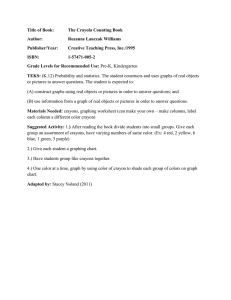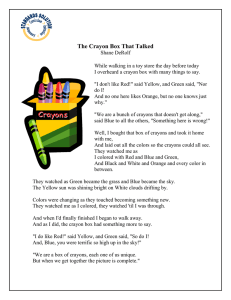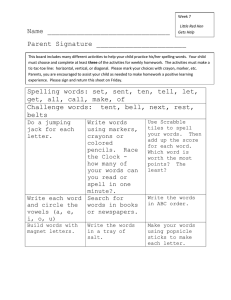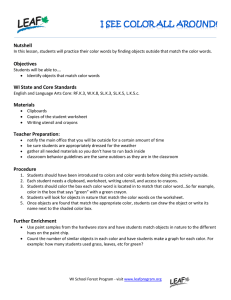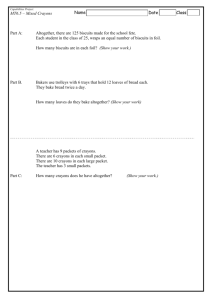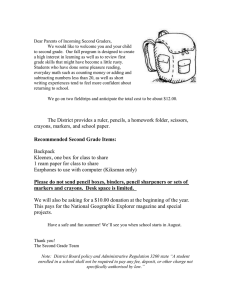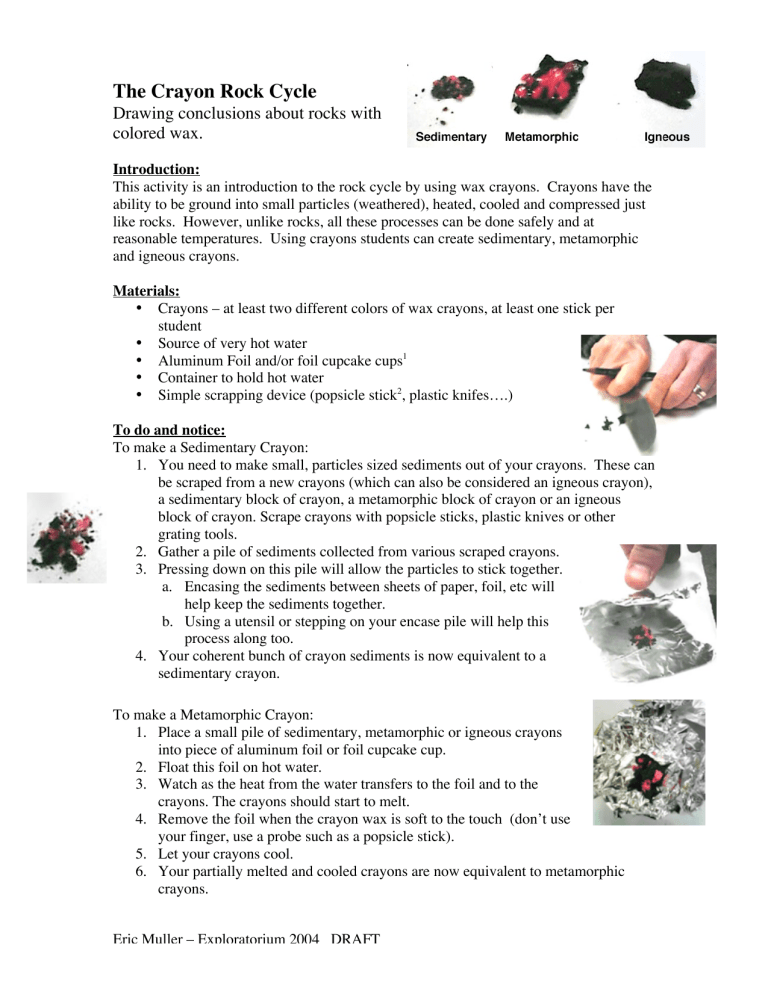
The Crayon Rock Cycle Drawing conclusions about rocks with colored wax. Introduction: This activity is an introduction to the rock cycle by using wax crayons. Crayons have the ability to be ground into small particles (weathered), heated, cooled and compressed just like rocks. However, unlike rocks, all these processes can be done safely and at reasonable temperatures. Using crayons students can create sedimentary, metamorphic and igneous crayons. Materials: • Crayons – at least two different colors of wax crayons, at least one stick per student • Source of very hot water • Aluminum Foil and/or foil cupcake cups1 • Container to hold hot water • Simple scrapping device (popsicle stick2, plastic knifes….) To do and notice: To make a Sedimentary Crayon: 1. You need to make small, particles sized sediments out of your crayons. These can be scraped from a new crayons (which can also be considered an igneous crayon), a sedimentary block of crayon, a metamorphic block of crayon or an igneous block of crayon. Scrape crayons with popsicle sticks, plastic knives or other grating tools. 2. Gather a pile of sediments collected from various scraped crayons. 3. Pressing down on this pile will allow the particles to stick together. a. Encasing the sediments between sheets of paper, foil, etc will help keep the sediments together. b. Using a utensil or stepping on your encase pile will help this process along too. 4. Your coherent bunch of crayon sediments is now equivalent to a sedimentary crayon. To make a Metamorphic Crayon: 1. Place a small pile of sedimentary, metamorphic or igneous crayons into piece of aluminum foil or foil cupcake cup. 2. Float this foil on hot water. 3. Watch as the heat from the water transfers to the foil and to the crayons. The crayons should start to melt. 4. Remove the foil when the crayon wax is soft to the touch (don’t use your finger, use a probe such as a popsicle stick). 5. Let your crayons cool. 6. Your partially melted and cooled crayons are now equivalent to metamorphic crayons. Eric Muller – Exploratorium 2004 DRAFT To make an Igneous Crayon: 1. Place a small pile of sedimentary, metamorphic or igneous crayons into piece of aluminum foil or foil cupcake cup. 2. Float this crayon containing foil on hot water. 3. Watch as the heat from the water transfers to the foil and to the crayons. The crayons should start to melt. 4. The crayons should be allowed to melt until a smooth liquid forms. 5. Carefully remove molten crayon wax and let cool. Your totally melted and cooled crayons are now equivalent to igneous crayons. What’s going on? This crayon cycle is designed to model the rock cycle. The rock cycle is a continuing process that has occurred throughout geologic time. One type of rock can become another rock type over time. This process can be thought of as a cycle and can be diagramed (see below). The particles that constitute an igneous rock held in one’s hands today may become part of a sedimentary or metamorphic rock in the distant future. Very little rock on the surface of the earth has remained fixed in its original rock type. Most rocks have undergone several iterations of the rock cycle. 3 1 Aluminum foil cupcake molds work well for this step – idea from Coral Clark. Use of a popsicle sticks for younger children - idea from Coral Clark. 3 The oldest known rocks on the surface of the earth are 3.8 billion years old (found in Greenland). 2 Eric Muller – Exploratorium 2004 DRAFT
